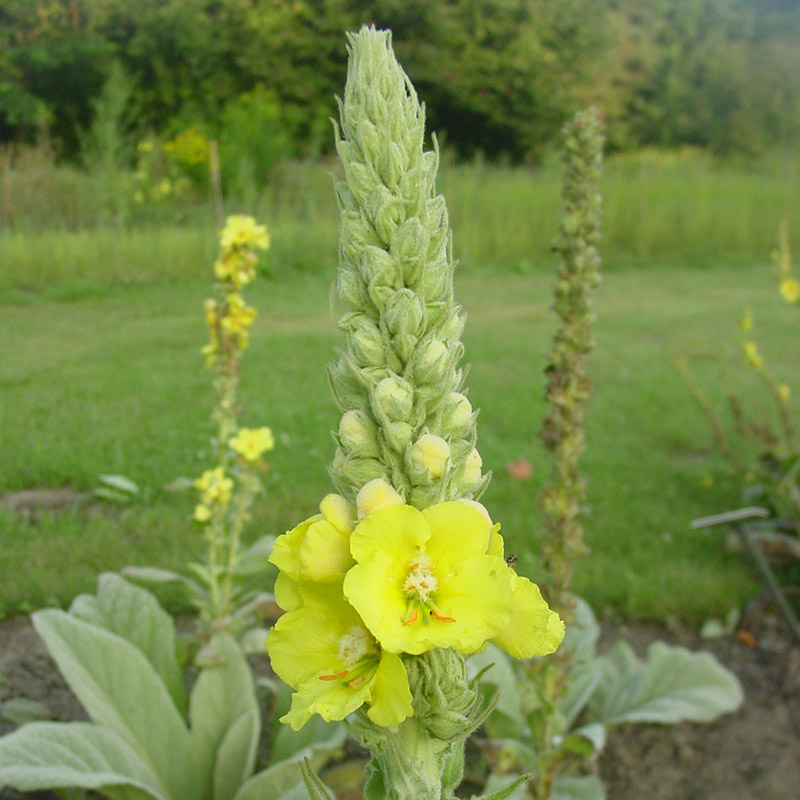Botanical name
Verbascum densiflorum Bertol.
Family
Scrophulariaceae
Common name
Great mullein, Flannel plant, Velvet dock, Woolly mullein, Hag's taper, Dense-flowered mullein, Orange mullein, Clasping-leaf mullein.
Information about the plant
Mullein is widespread in Central and Southern Europe, Asia Minor, Morocco, and various regions of the temperate zone. The genus name Verbascum has been translated into English (Latin for 'Verbascum' = mullein). There are also indications that previously, the dried stems were soaked in resin or wax and used as candles or torches. With its abundant golden-yellow blossoms and tall stem resembling a large candle, the plant lives up to its name.
A distinction is made between different species, and the dense-flowered mullein is characterized by its height of up to 2 m and flowers measuring up to 5 cm in diameter. The various species epithets describe distinctive features, e.g. here Latin “densiflorum” = densely flowered – densely covered with flowers.
The leaves form a basal rosette and are oppositely arranged along the stem. They are covered with felt-like hairs. The yellow flowers are slightly asymmetrical and grow in clusters of 2 to 5 along a long-tufted spike. Their petals grow together at the base; the upper two are slightly smaller than the lower three and are externally covered with fine woolly hairs. The three short-stalked stamens are conspicuously hairy, while the two long-stalked stamens are leafless. The flowering time extends from July to September.
Medicinally used parts of plants (herbal drug)
The dried petals that have grown together to form the corolla, along with the five attached stamens (mullein flowers – Verbasci flos), are used. The fine hairs on the petals and the striking hairs on the three short-stalked stamens give the dried flowers a ‘woolly’ appearance, which is why the drug is also known as ‘woolly flowers’.
The commercially available drug is primarily sourced from cultivations in Egypt, Bulgaria, and the Czech Republic.
Constituents of the herbal drug
Mullein flowers contain mucilage, flavonoids, iridoids, and triterpenoid.
Quality of the drug
The quality of mullein flowers (Verbasci flos) is specified in the European Pharmacopoeia (Ph. Eur.). According to the Pharmacopoeia, flowers of Common mullein (Verbascum phlomoides L.) and Great mullein (Verbascum thapsus L.) may also be used.
Medical applications
Recognised medical use
The HMPC has classified mullein flowers (woolly flowers) as a traditional herbal medicinal product (see ‘Traditional use’).
ESCOP: For the relief of symptoms associated with the common cold, such as coughs or sore throats, and as a mild expectorant. These applications are based on long-standing use.
Traditional use
Mullein flowers (woolly flowers) have been classified by the HMPC as a traditional herbal medicinal product (Article 16a of Directive 2001/83/EC). Based upon long-standing use, mullein flowers (woolly flowers) can be used to treat sore throats associated with dry coughs and colds.
Herbal drug preparations in finished dosage forms
- Cut drug for tea preparations and tea blends (cough tea)
Dosage
Tee: Drink a warm cup of tea made from mullein flowers 3 to 4 times a day. Daily dose: 4.5 to 8 g of the drug.
Preparation of a tea
Pour approximately 150 ml of boiling water over 1.5 to 2 grams of finely chopped mullein flowers (woolly flowers) and strain after 10 to 15 minutes. To make better use of the mucilage in the drug, prepare the tea with cold water, strain after 2 hours, and briefly bring to a boil.
Notes
There are no safety studies available on use of mullein flowers during pregnancy and lactation. The use in children under 12 years of age is not recommended due to a lack of evidence.
Side effects
None known.
Interactions
None known.
References
Herbal drug monographs
Further literature
Commentary on the European Pharmacopoeia (Mullein flowers – woolly flowers, No. 1853)


